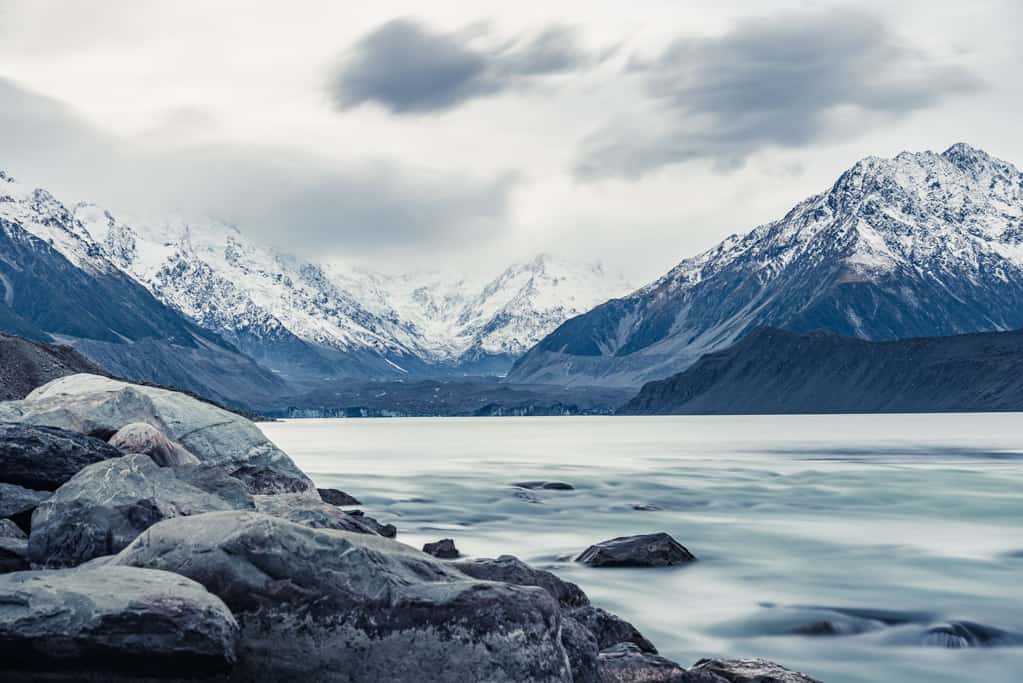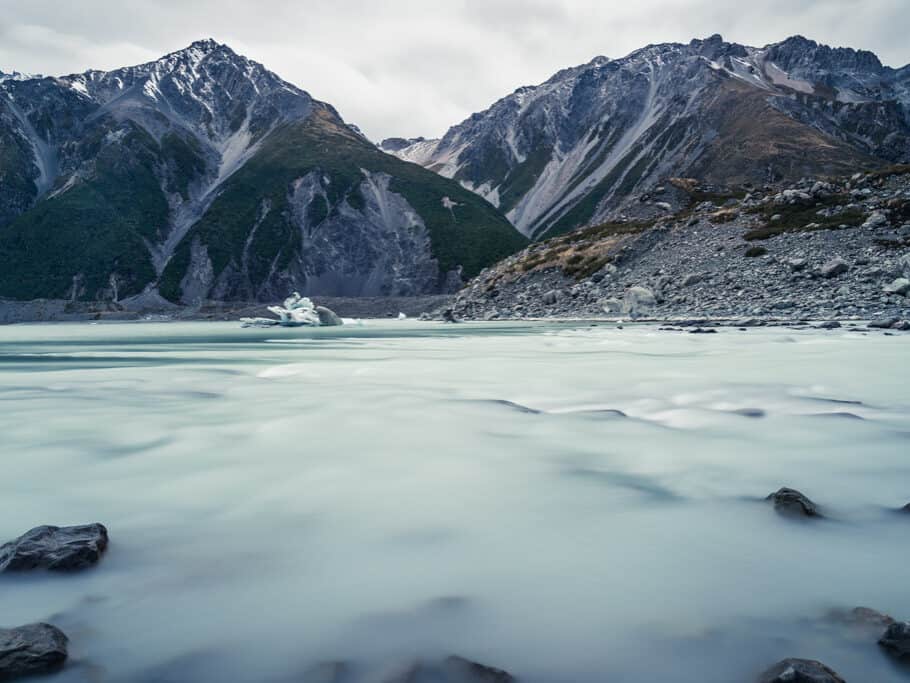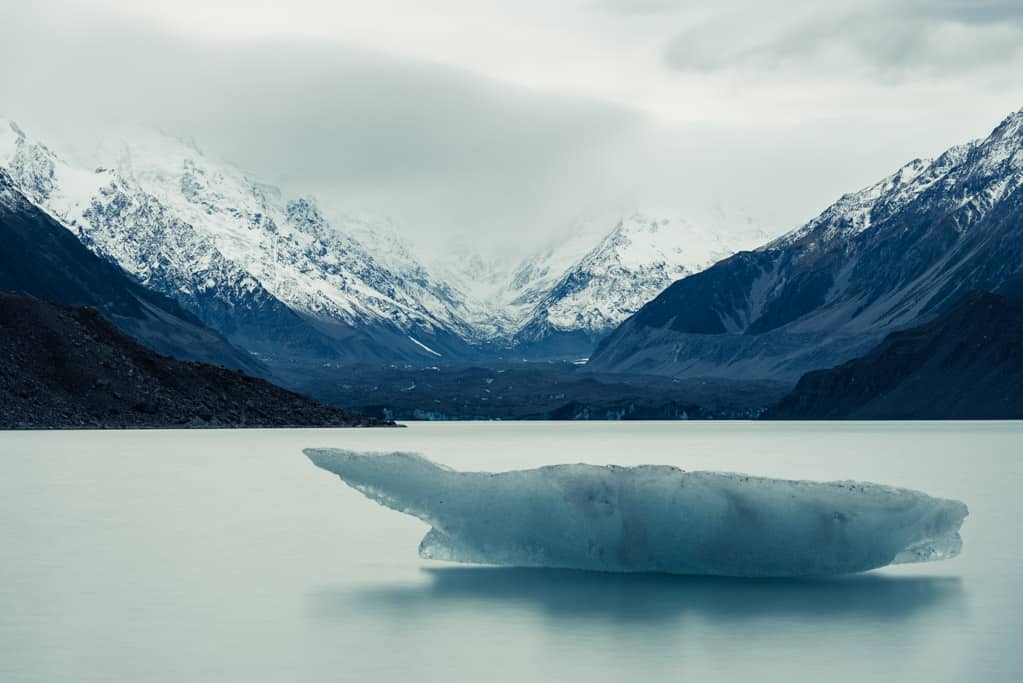Hike & walk | Mount Cook National Park | New Zealand
Explore the Best Hikes in Mount Cook National Park
Text | Anninka Kraus
Photography | Tobias Kraus

New Zealand Canterbury
Aoraki/Mount Cook National Park is home to New Zealand’s highest mountains, the country’s longest glaciers, small icebergs drifting in milky blue glacial lakes, and a pitch-black night sky speckled with millions of stars.
The journey to the park via Mount Cook Road easily qualifies for a scenic drive, the views of Mount Cook from the highway are that stunning, and the adventurous spirit found among vacationers down that dead-end road far from urbanisation reminded me of the small villages in US National Parks, minus the American comfort and amenities.
All of New Zealand’s highest peaks with summits over 3000m lie in the Southern Alps, including the highest, Mount Cook, or Aoraki as it is called in Maori, at 3724m. Its three summits are the highlight of Mount Cook National Park and flanked to the east by Tasman Glacier – the longest in New Zealand but rapidly retreating – and to the southwest by Hooker Glacier. Tiny Mount Cook village that some 200 people call home consists of the iconic Hermitage Hotel, a tourist information centre, an overpriced petrol station, no shop, and a couple of restaurants.
We started our trip to Mount Cook National Park in Christchurch and quickly realized that not just the national park itself is worth the drive, but the journey via Lake Tekapo, Twizel, and Lake Pukaki is one of the most beautiful road trips in the country if not the world.
jump ahead.
Embark on a scenic Road Trip from Christchurch to Mount Cook National Park and discover the park’s best hikes.
1. Lake Tekapo
2. Lake Pukaki
3. Twizel
4. Hiking in Mount Cook National Park
5. Mueller Hut Route
6. Sealy Tarns Track
7. Hooker Valley Track
8. Kea Point Track
9. Blue Lakes and Tasman Glacier walks







Aoraki/Mount Cook National Park spans 60 kilometres along the south-eastern side of the Southern Alps in Canterbury's Mackenzie Country.
what to expect.
Mount Cook National Park is a majestic alpine landscape of superlatives boasting the country’s highest mountains, longest glaciers, and darkest night skies studded with a dazzling display of brightly lit stars and galaxies
The number of hiking trails accessible to hikers without mountaineering experience is limited also in summer, but the trails that do exist are in perfect shape and some of New Zealand’s best
Starting from Christchurch, the journey via Lake Pukaki, Lake Tekapo, and Twizel and through the park on SH 80 is breath-taking and arguably the best road trip in the country
Mount Cook is located in the UNESCO Aoraki MacKenzie International Dark Sky Reserve – with 4300 square kilometres the largest reserve of its kind in the world and one of the best places in the world for stargazing with very little light pollution
location & park information.
Directions: Aoraki/Mount Cook National Park spans 60 kilometres along the south-eastern side of the Southern Alps in Canterbury’s Mackenzie Country and is a 4-hour drive from Christchurch via State Highway 8 and an equally long drive along the coast and up the Waitiki Valley from Dunedin.
The only road access into the park is via State Highway 80 (Mount Cook Road), but the 55km journey through the park starting at Lake Pukaki is stunning so take your time and be prepared to stop often, at one of the lookout points or when farmers move livestock between paddocks and you suddenly share the road with a few hundred sheep.
Mount Cook village is located at the end of SH 80. At the last intersection, turn left for the visitor centre, YHA backpackers, and petrol station, and right for the Hermitage Hotel. To access White Horse Hill Campsite and car park, and trailheads for the Mueller Hut Route and tracks to Sealy Tarns, Kea Point, and Hooker Valley turn right onto Hooker Valley Road before reaching Mount Cook village. For the Blue Lakes and Tasman Glacier walks follow Tasman Valley Road along the Tasman River to Tasman Glacier car park.
There is no fee to be paid or permit required to enter Aoraki/Mount Cook National Park or walk any of the hiking trails. Overnight stays at Mueller Hut however require prior reservation online.
When to visit Mount Cook: The park is stunning at any time of the year, but some hikes at higher altitudes like the Mueller Hut Route and Sealy Tarns Track are only recommended in summer (December to February) and possibly shoulder season (consult with the Aoraki/Mount Cook Visitor Centre for the current conditions) unless you have adequate mountaineering experience, an ice axe, crampons, an avalanche transceiver, a snow shovel and a probe.
Best Spots for Photography in Mount Cook National Park: The proximity to staggering peaks and mountainous altitudes make the alpine terrain in Mount Cook National Park a perfect setting for landscape photography, especially at sunrise or sunset when the mountains are doused in golden alpenglow. My favourite memory of the park is watching the harsh, barren rock of peaks turn blackish as the sun fades and the stiff evening breeze that’s brushed soft fleecy clouds across the sky colour in vibrant pinks and purples day dies down before day turns into night.
The best spots to watch the sunrise are Mueller Hut at 1800m or Hooker Lake at the end of the Hooker Valley Track, which ventures closer to Aoraki/Mount Cook than any other walking track in the park.
The best spot to watch the sunset is at Sealy Tarns when the snow-covered mountains coloured in pinks and purples are reflected in the tarns.
Mount Cook Road easily qualifies as a scenic route and lookouts along the road offer great views of the valley against the backdrop of the Southern Alps.
The Blue Lakes and Tasman Glacier walks offer different perspectives of Tasman Glacier and its startling blue terminal lake – from a viewpoint on the moraine wall and from the lakeshore.
Where to stay in Mount Cook: The only downside of staying in the park proper is the lack of decent, affordable accommodation. The first time we visited, we were put off splurging on a room at the Hermitage Hotel by the many discouraging 1-star reviews one finds online and stayed at the YHA instead. I still regret that decision and shudder at the memory of bed bugs feasting on us during the night. So, on our second visit, we booked the Hermitage and its mid-80s rundown, cheap motel room facilities were as disappointing as expected and ridiculously overpriced, but without bed bugs. As we’ve now exhausted most options, we’ll stay at the campground or outside the park next time. Twizel and Lake Ohau both offer accommodation to suit most tastes and budgets 45 and 80 minutes from Mount Cook village respectively.
Where to eat: Unfortunately, there’s not one restaurant in the park I feel comfortable recommending. It’s probably best to make this a self-catering visit and bring all your food with you. The closest place to stock up on supplies is Twizel with two larger FourSquare supermarkets.
What to do in Mount Cook National Park: Hike! There’s little else to do there except visit the Sir Edmund Hillary Alpine Centre and the DOC Aoraki/Mount Cook visitor centre.
Drive Christchurch - Lake Tekapo | 245km | 3.5 hours travel time
Lake Tekapo
After a 3-hour drive from Christchurch through the heart of the Canterbury region, we arrive at the first of the lakes in the central Mackenzie Basin.
Lake Tekapo is 83 square kilometres in size and largely uninhabited except for a small tourist village of the same name on its southern shore. Fed by glaciers, the water is milky and the sun reflecting off the water saturated with rock flour (finely ground rock) turned the lake into an intense turquoise. It’s a very startling and contrasting colour amid bronze, semi-arid tussock grasslands and barren mountain slopes, and what touches me deeply is the absence of human influence on our surroundings. I feel the same gazing at wide riverbeds where the river was reduced in size to a runlet by the sheer abundance of polished white pebbles on either side, sandbanks, and even bushes and small trees that preyed on breaks between floods.
Natural feels unnatural to me because I usually see lakeshores framed by flat-roofed condo buildings and rivers cooped up in canals. The Southern Alps, a mountain range that runs along much of the length of the South Island, provide a magnificent backdrop to a most impressive location for a wedding ceremony, provided one wants to get married in a church and the most photographed in New Zealand at that. I would have placed the Church of the Good Shepherd in the Scottish Highlands.
Not that I know that region, but Skyfall 007 left me with an impression of Scotland that closely resembles this landscape and is a perfect setting for the sturdy chapel built of brownish-grey uneven boulders. The chapel is functional and unpretentious also on the inside as if to devote more attention to the huge window. A truly outstanding panorama of Lake Tekapo and the Southern Alps is revealed, where usually an alter stands.
Drive Lake Tekapo - Lake Pukaki | 45km | 30 minutes travel time
Lake Pukaki
A half-hour southwest of Lake Tekapo lies Lake Pukaki, which cannot pride itself on a famed chapel but a stunning view of New Zealand’s highest peak, Mount Cook at 3724m.
It’s a dwarf mountain compared to peaks in Nepal that towered over us for days, yet was magnified by its flat surroundings. The Southern Alps rise unexpectedly and add steel-grey rock slopes and gleaming snow peaks to the colour palette of brownish tussock, turquoise glacier water and dark green pines.
Drive Lake Pukaki - Twizel | 10km | 10 minutes travel time
Twizel
We come to Twizel next, a 10-min drive south from Lake Pukaki and keeping with tradition, my birthday is celebrated in a unique and memorable place. On that day some years ago, we started on a cruise from Punta Arenas to Cape Horn. I still blush at the memory of the captain balancing a cake with candles in front of him and singing happy Birthday in Spanish for me together with the first engineer and the expedition leader – in the dining room in front of 200 passengers and the crew.
I don’t need that much attention again and pick minuscule Twizel in Canterbury Mackenzie High Country that counts little more than 1000 permanent inhabitants.
Originally built in 1968 as the base for the Upper Waitaki Power Development, the tiny town is now relying on visitors to several close by lakes and Mount Cook National Park and cyclists recuperating in Twizel after tackling the 54km-stretch from Lake Tekapo on the Alps 2 Ocean Cycle Trail (link). Matuka Lodge, our accommodation for three nights, instead relies entirely on low-key luxury with king rooms and private porches to make guests happy. Lying in our private whirlpool with lavender-scented bubbles brushing against my cheeks I can find absolutely nothing to fault.
Well, we should have been able to gaze at magnificently bright stars twinkling in one of the world’s darkest, driest, and most unpolluted skies through the floor to ceiling window but can’t. The full moon, bathing the surrounding grasslands and the silhouette of the Southern Alps in the distance in velvet blue twilight, drowns all night vision.
Prepare for your trip
Things to know about Hiking in Mount Cook
Backtracking 10 minutes of our journey from Twizel to Lake Pukaki, we turn left into Mount Cook Road (SH 80), which arguably qualifies as the most spectacular stretch of road in the country as it swoops along the startling milky blue waters of Lake Pukaki and straight into the heart of Mount Cook’s alpine wilderness.
A word of caution though: Don’t come here expecting an alpine wellness retreat – on the contrary, this is the place to swap 5-star luxury accommodation and a private whirlpool for a bunk in one of two bunkrooms sleeping fourteen each, half of whom snore and drool on plastic covered mattresses, and an outhouse, outside as the name suggests.
Why? Because luxury is seldom found at 1800m, the elevation of Mueller Hut on Sealy Range with one of New Zealand’s most dazzling 360-degree panoramas.
There are no multiple day hikes in Mount Cook National Park that you can do without adequate mountaineering experience, but Mueller Hut Route takes you into alpine terrain on a well-marked trail where you can spend the night at Mueller Hut at 1800m. In summer (December to February) moderate hiking experience is sufficient to reach the hut and the steep 1000m uphill scramble will be well rewarded with a 360-degree panorama of New Zealand’s highest snow-covered peaks and glaciers clinging to vertical rock faces.
In winter, attempt this hike only if you have adequate mountaineering experience, an ice axe, crampons, an avalanche transceiver, a snow shovel, and probe, and consult with the DOC staff at the visitor centre before starting your hike. Also, in spring/autumn check with the visitor centre for the current conditions, which at 1800m may vary considerably to those in Mount Cook village.
Less experienced hikers have several easier and shorter hikes without much altitude gain to choose from, such as the Hooker Valley and Kea Point tracks and Blue Lakes and Tasman Glacier walks. The views offered on the shorter hikes are none the less beautiful and by no means inferior to those at higher altitudes. The Sealy Tarns Track, which later turns into Mueller Hut Route is a great compromise for many, as it packs 2’200 steps and 600m elevation gain into a 2.5-kilometres uphill climb but on a well-maintained path.
Before you go, be aware though that Mount Cook is one of the most visited spots in the South Island and when international tourists are back, the sheer mass of people is likely to negatively impact your experience in the park. If it’s solitude you seek on your hikes and the best conditions for landscape photography, consider exploring the park early or late in the day (take your headlamp and let someone know your plans). We timed all our walks and day hikes in Mount Cook to coincide with sunrise or sunset and didn’t have to share any of the photography spots we picked (see above) with a single soul.
Hike | Out & back trail | 1-2 days
Mueller Hut Route
The hike to Mueller hut at 1800m on the Sealy Range is arguably the most scenic and rewarding in Mount Cook National Park with 360-degree views of Aoraki/Mount Cook, Mount Sefton, and the surrounding snow-covered mountainscape, and can be done in one or two days with an overnight stop at the hut.
Hike | Out & back trail | 2-3 hours
Hooker Valley Track
The Hooker Valley Track is much easier than the hike to Mueller Hut, but regardless one of the prettiest day hikes we’ve ever done and among the most popular and well frequented in the country.
Crossing over three large suspension bridges and meandering through the valley blanketed with snow tussock, wildflowers, and spear grass, the track arrives at Hooker Lake lookout with magnificent views of Aoraki/Mount Cook and the Southern Alps mountain range.
The only downside is the track’s popularity – if it’s solitude you seek more than an endless stream of chattering tourists, consider an early start (5 am was early enough to watch the sunrise at Hooker Lake in April).
Hike | Out & back trail | 2-4 hours
Sealy Tarns Track
Aptly named the ‘stairway to heaven’ this track squeezes 2’200 steps and a 600m elevation gain into a 2.5-kilometres uphill hike. It’s a ferociously steep walk but the footpath itself is easy to follow and involves no scrambling over rocks or climbing.
Walk | Out & back trail | 1-2 hours
Kea Point Track
Kea Point Track is one of the shorter, more gentle walks in the park. Expect a 2-hour return walk from Mount Cook village or a 1-hour return walk from White Horse Hill Campsite at the end of Hooker Valley Road. The track is also signposted from the Hermitage Hotel if that’s where you’re staying.
Traversing gently undulating subalpine grasslands where, in 1913, a stream carved its way through the valley from Mueller Glacier Lake and badly damaged the original Hermitage hotel, the walkway climbs gently for 3 kilometres to a viewing deck directly vis-a-vis the Mueller Glacier moraine wall and milky-turquoise glacial lake.
The views are magnificent all around: the mighty Sealy Range rises in the back, Mount Sefton to your left at 3151m, next to The Footstool at 2764m, and mighty Aoraki/Mount Cook towers far back in the north, with Hooker Valley extending to your right.
The Kea Point Track connects to the Sealy Tarns Track at a track junction 850m northwest of the White Horse Hill Campsite, in case you want to link the two.
track details.
Start/End: White Horse Hill car park at the end of Hooker Valley Road (alternative starting points – see options below)
Distance: 3.2km return from White Horse Hill car park
Time: 1 hour return from White Horse Hill car park | 2 hours return from Mount Cook village
Elevation gain: 95 meters (+/-) (lowest point: 765m / highest point: 860m)
Difficulty: easy
Options: alternative starting points are Terrace Road near the Aoraki/Mount Cook Visitor Centre or the Hermitage Hotel; Kea Point Track connects to the Sealy Tarns Track in case you want to combine the two
Permits: none required
Further information: Official DOC information



